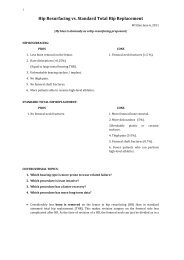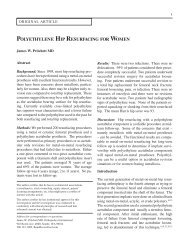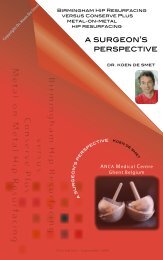- Page 1 and 2:
Hip and Knee Arthroplasty ANNUAL RE
- Page 3:
Australian Orthopaedic Association
- Page 6 and 7:
PRIMARY PARTIAL KNEE REPLACEMENT...
- Page 8 and 9:
PRIMARY TOTAL HIP REPLACEMENT......
- Page 10 and 11:
PRIMARY TOTAL KNEE REPLACEMENT ....
- Page 12 and 13:
viii
- Page 14 and 15:
RIMARY TOTAL RESURFACING HIP REPLAC
- Page 17 and 18:
EXECUTIVE SUMMARY This executive su
- Page 19 and 20:
INTRODUCTION This is the eighth Ann
- Page 21 and 22:
supply aggregate data and negotiati
- Page 23 and 24:
PARTICIPATING HOSPITALS & COORDINAT
- Page 25 and 26:
VICTORIA PUBLIC HOSPITALS Austin He
- Page 27 and 28:
QUEENSLAND PUBLIC HOSPITALS Bundabe
- Page 29 and 30:
WESTERN AUSTRALIA PUBLIC HOSPITALS
- Page 31 and 32:
HIP REPLACEMENT GENERAL INTRODUCTIO
- Page 33 and 34:
difference is also evident when com
- Page 35 and 36:
Table HG2: Number of Hip Replacemen
- Page 37 and 38:
Table HG4: Primary Hip Replacement
- Page 39 and 40:
Table HG8: Primary Total Resurfacin
- Page 41 and 42:
The use of monoblock prostheses in
- Page 43 and 44:
PRIMARY PARTIAL HIP REPLACEMENT 1/9
- Page 45 and 46:
Table HP2: 10 Most Common Unipolar
- Page 47 and 48:
Table HP4: 10 Most Common Bipolar H
- Page 49 and 50:
Table HP6: Primary Partial Hip Repl
- Page 51 and 52:
Table HP14: Primary Partial Hip Rep
- Page 53 and 54:
Table HP15: Primary Unipolar Monobl
- Page 55 and 56:
Table HP19: Primary Bipolar Hip Rep
- Page 57 and 58:
Table HP24: Primary Unipolar Monobl
- Page 59 and 60:
Table HP28: Primary Bipolar Hip Rep
- Page 61 and 62:
Table HP32: Primary Unipolar Modula
- Page 63 and 64:
Table HP34: Primary Bipolar Hip Rep
- Page 65 and 66:
Primary Unipolar Modular Hip Replac
- Page 67 and 68:
Primary Bipolar Hip Replacement Pro
- Page 69 and 70:
PRIMARY TOTAL HIP REPLACEMENT The a
- Page 71 and 72:
Effect of Bearing Surface For the f
- Page 73 and 74:
since 2004. The three total resurfa
- Page 75 and 76:
combination has been used in 1,649
- Page 77 and 78:
Table HT2: Primary Conventional Tot
- Page 79 and 80:
Table HT6: 10 Most Common Femoral C
- Page 81 and 82:
Table HT8: 10 Most Common Femoral C
- Page 83 and 84:
Table HT10: 10 Most Common Acetabul
- Page 85 and 86:
Table HT12: 10 Most Common Primary
- Page 87 and 88:
Primary Conventional Total Hip Repl
- Page 89 and 90:
Table HT19: Primary Conventional To
- Page 91 and 92:
Table HT21: Primary Conventional To
- Page 93 and 94:
Figure HT18: Cumulative Percent Rev
- Page 95 and 96:
Table HT25: Primary Conventional To
- Page 97 and 98:
Figure HT23: Cumulative Percent Rev
- Page 99 and 100:
Figure HT26: Cumulative Percent Rev
- Page 101 and 102:
Table HT31: Primary Conventional To
- Page 103 and 104:
Table HT33: Primary Conventional To
- Page 105 and 106:
Primary Total Resurfacing Hip Repla
- Page 107 and 108:
Table HT39: Primary Total Resurfaci
- Page 109 and 110:
Table HT41: Primary Total Resurfaci
- Page 111 and 112:
Table HT45: Primary Total Resurfaci
- Page 113 and 114:
Table HT48: Yearly Cumulative Perce
- Page 115 and 116:
Figure HT34-43: Cumulative Percent
- Page 117 and 118:
Primary Total Resurfacing Hip Repla
- Page 119 and 120:
REVISION HIP REPLACEMENT This repor
- Page 121 and 122:
REVISION HIP REPLACEMENT 1/9/1999 -
- Page 123 and 124:
‘Revision of Known Primary’ Hip
- Page 125 and 126:
Table HR10: Outcomes of ‘Revision
- Page 127 and 128:
knee increased from 29.4% in 2003 t
- Page 129 and 130:
Table KG2: Number of Knee Replaceme
- Page 131 and 132:
Table KG4: Primary Knee Replacement
- Page 133 and 134:
PRIMARY PARTIAL KNEE REPLACEMENT Th
- Page 135 and 136:
Effect of Age and Gender The risk o
- Page 137 and 138:
Primary Partial Resurfacing Knee Re
- Page 139 and 140:
Table KP6: Primary Patella/Trochlea
- Page 141 and 142:
Table KP12: Primary Unicompartmenta
- Page 143 and 144:
Table KP16: Primary Unicompartmenta
- Page 145 and 146:
Table KP20: Primary Unicompartmenta
- Page 147 and 148:
Table KP22: Primary Unicompartmenta
- Page 149 and 150:
Primary Patella/Trochlear Knee Repl
- Page 151 and 152:
Figure KP11-14: Cumulative Percent
- Page 153 and 154:
decrease in use and now accounts fo
- Page 155 and 156:
as having a higher than anticipated
- Page 157 and 158:
Table KT2: 10 Most Common Femoral C
- Page 159 and 160:
Table KT4: 10 Most Common Femoral C
- Page 161 and 162: Figure KT5: Trends in Prosthesis Fi
- Page 163 and 164: Table KT10: Primary Total Knee Repl
- Page 165 and 166: Figure KT10: Primary Total Knee Rep
- Page 167 and 168: Table KT16: Primary Total Knee Repl
- Page 169 and 170: Table KT20: Primary Total Knee Repl
- Page 171 and 172: Table KT23: Yearly Cumulative Perce
- Page 173 and 174: Table KT25: Yearly Cumulative Perce
- Page 175 and 176: Table KT27: Yearly Cumulative Perce
- Page 177 and 178: Table KT30: Primary Unicompartmenta
- Page 179 and 180: Table KT31: Yearly Cumulative Perce
- Page 181 and 182: Table KT33: Yearly Cumulative Perce
- Page 183 and 184: Figure KT24-KT33: Cumulative Percen
- Page 185 and 186: REVISION KNEE REPLACEMENT This repo
- Page 187 and 188: p
- Page 189 and 190: Figure KR1: Trends in Usage for Rev
- Page 191 and 192: ‘Revision of Known Primary’ Kne
- Page 193 and 194: Table KR10: Outcome of ‘Revision
- Page 195 and 196: Table KR14: Outcome of ‘Revision
- Page 197 and 198: CEMENT IN HIP AND KNEE REPLACEMENT
- Page 199 and 200: CEMENT IN HIP AND KNEE REPLACEMENT
- Page 201 and 202: Table C3: Top 10 Cements used in Re
- Page 203 and 204: Table C7: Yearly Cumulative Percent
- Page 205 and 206: Table C11: Yearly Cumulative Percen
- Page 207 and 208: MORTALITY FOLLOWING PRIMARY HIP AND
- Page 209 and 210: Table M5: Mortality following Prima
- Page 211: Appendices APPENDIX 1 Glossary of S
- Page 215 and 216: INTRODUCTION - about the Registry A
- Page 217 and 218: APPENDIX 5 ICD-10-AM Codes PRIMARY






